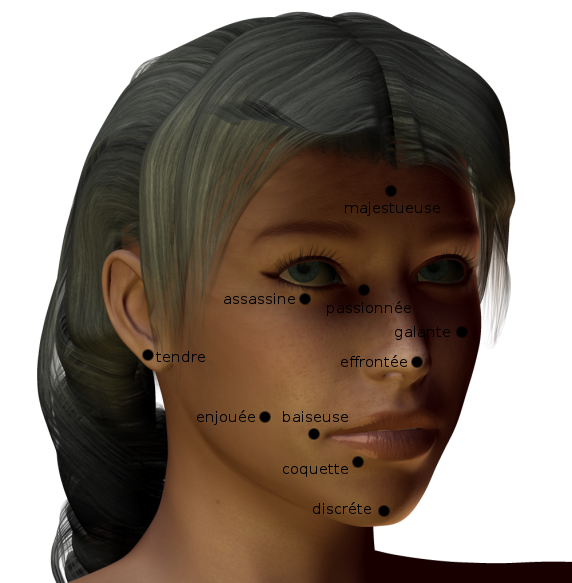Back to fravia's Reality Cracking section
| Where & who Beauty spots had a specific meaning, which depended on their location on the skin. Here Giuseppe Tassini's description: Near the mouth they meant voluptuousness. There were TWO possible areas: close to the underlips, in which case the mosquete were called civette (literally owl, but in italian it means also "One given to flirting", i.e: coquette) and close to the corners of the mouth, in which case the moschete were called assassine literally: "able to kill". On the throat (or on the cheek) they conveyed a meaning of gallantry. This type of moscheta was in fact called galante i.e.: gallant or tirabaci i.e.: lovelock. On the nose a faked beauty spot shows boldness and was called sfrontata, i.e.: shameless). A moscheta on the eye-corner indicates passion: appassionata (i.e.: passionate). This should not be confused with the irresistibile, that was always located near one of the eyes. In the middle of the forehead the beauty spot meant grandeur (and was called maestosa, i.e.: grand). |  |
 |
La friponne
L'assassine ou la passionnée La baiseuse (faut comprendre dans son sens primitif :-) La coquette La majestueuse La galante L'enjouée La recéleuse ou la voleuse L'effrontée (ou gaillarde) La discréte La généreuse La tendre |
Sous la lèvre, vers le menton (discréte)
Assassine: sous l'œil droit. Passionnée: près de l'oeil Au coin de la bouche - coin droit de la lèvre Sur la lèvre Sur le front Sur la joue - Sous l'œil gauche - Sous la pommette Dans le creux du sourire Posée pour cacher un bouton Sur le bout du nez Menton Sein Sur le lobe de l'oreille |
